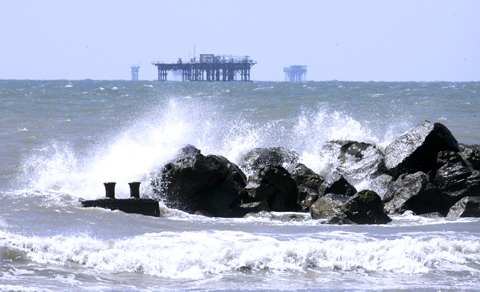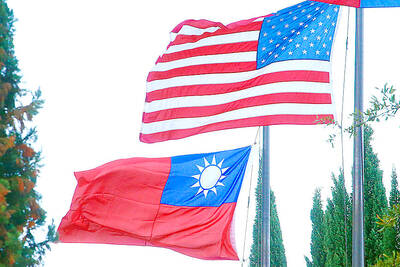The booming oil hub called Port Fourchon, a nerve center in the US’ oil supply chain, is turning into a sitting duck for hurricanes as the beach that protects it from the Gulf of Mexico washes away.
The 5km-long sand bank — blasted last year by hurricanes Gustav and Ike, and by Katrina and Rita three years before that — is nearly all that keeps the Gulf from thrashing the pipelines and shipyards that handle 15 percent of all crude oil flowing to inland refineries.
Port Fourchon, about 112km south of New Orleans, also supports 90 percent of the Gulf’s 3,700 offshore platforms and connects with the Louisiana Offshore Oil Port — the only US port capable of handling the largest oil tankers. The offshore port handles 1.5 million barrels of oil a day and ties in by pipeline to about half of domestic refining capacity.

PHOTO: AP
Officials worry that unless work begins immediately to bolster the port’s defenses, a direct hit from a strong Category 3 storm or worse could wipe out its waterways, docks, giant cranes, tanks and helipads, crippling the facility for weeks and creating a national energy crisis overnight.
The Army Corps of Engineers hopes to begin work in 2011 on a shoreline restoration project for the Caminada Headland, where Port Fourchon sits.
But this month and next month are the most active months, and catastrophic storms are not unheard of even during the sleepiest of seasons.
“Hope and pray there’s not another hurricane before we can get out there and do the work,” said Fay Lachney, the corps’ project manager.
Beyond the potential energy crisis, a badly damaged Port Fourchon poses an environmental risk, said Wilma Subra, a Louisiana chemist and environmental activist. On a survey after Gustav last year, Subra found the area littered with hazardous debris from rigs, ships and oil and gas facilities.
An environmental catastrophe isn’t likely though, since the port is not a major storage spot for oil and pipelines typically are emptied when a storm threatens.
Port officials are eager for the corps work to begin but say they need to immediately shore up the facility’s eastern flank with US$20 million of improvements. So far, the port has not been able to raise money for breakwaters, man-made dunes and other protection. The Federal Emergency Management Agency has said it does not pay for damage to a natural beach, and a proposal to use stimulus funds was rejected.
Chett Chaisson, the port’s economic development director, said he was trying to raise US$10 million in state, port and local funds, and that he would turn to the energy industry “if we come up short ... if we can’t find funding through the normal sources.”
Mike Lyons, a lawyer for the Louisiana Mid-Continent Oil and Gas Association, said the energy industry has done a great deal to stop erosion in Louisiana.
“There’s quite a bit of money coming in from the industry’s operations assisting in the state’s efforts to do coastal restoration work,” Lyons said.
The industry’s biggest direct contribution to Port Fourchon came when Chevron spent US$500,000 on beach restoration at the port in the early 1990s, Chaisson said. More recently, Shell helped plant vegetation on a new manmade ridge.
For now, about all the people who run the port can do is watch the sand wash away. Port staff patrol the area looking for breaches and erosion, dispatching reports to state and federal agencies, pleading for action.
“Every storm, the beach rolls back. We’re getting to a critical point now,” Chaisson said. “We keep telling that story and the money just doesn’t come.”
For its part, the Gulf is not procrastinating.
A recent patrol cruised past a nearly meter-long redfish skeleton bleached by the sun, then came to an abrupt halt. A new breach blocked the way.
“This is bad,” port police officer Mitchell Hohensee said.
A couple of weeks before, he’d driven by with no problem. “I’m going to have to get the GPS coordinates for this one,” he said.
GPS coordinates help map the site. Also, Hohensee said, the Coast Guard would need to know if a pipeline running through the area had been exposed.
Last year’s storms washed away about 30m of beach on the Caminada Headland, leveled dunes and breached the beach
Once the waters breach the beach, it creates a tidal prism: water flows between the Gulf and the body of water behind the beach, the breach growing larger with time.
It’s possible the breaches will fill in on their own, as has happened before but the long-term combination of erosion, storms and breaches may be too much.
The land on which the port sits is already isolated, reachable only by the narrow two-lane road to the mainland that often floods.
Work is continuing on a new elevated road to keep the outpost connected as Louisiana’s coastline continues receding.
“We know that the port is going to be a little island out there in the water that you have to get to by an elevated highway,” Chaisson said.
But, he said, “if it totally goes, this country has a big problem ... It’s much cheaper to protect this port than it is to try and build it somewhere else.”

UPDATED (3:40pm): A suspected gas explosion at a shopping mall in Taichung this morning has killed four people and injured 20 others, as emergency responders continue to investigate. The explosion occurred on the 12th floor of the Shin Kong Mitsukoshi in Situn District (西屯) at 11:33am. One person was declared dead at the scene, while three people were declared deceased later after receiving emergency treatment. Another 20 people sustained major or minor injuries. The Taichung Fire Bureau said it received a report of the explosion at 11:33am and sent rescuers to respond. The cause of the explosion is still under investigation, it said. The National Fire

ACCOUNTABILITY: The incident, which occured at a Shin Kong Mitsukoshi Department Store in Taichung, was allegedly caused by a gas explosion on the 12th floor Shin Kong Group (新光集團) president Richard Wu (吳昕陽) yesterday said the company would take responsibility for an apparent gas explosion that resulted in four deaths and 26 injuries at Shin Kong Mitsukoshi Zhonggang Store in Taichung yesterday. The Taichung Fire Bureau at 11:33am yesterday received a report saying that people were injured after an explosion at the department store on Section 3 of Taiwan Boulevard in Taichung’s Situn District (西屯). It sent 56 ambulances and 136 paramedics to the site, with the people injured sent to Cheng Ching Hospital’s Chung Kang Branch, Wuri Lin Shin Hospital, Taichung Veterans General Hospital or Chung

‘TAIWAN-FRIENDLY’: The last time the Web site fact sheet removed the lines on the US not supporting Taiwanese independence was during the Biden administration in 2022 The US Department of State has removed a statement on its Web site that it does not support Taiwanese independence, among changes that the Taiwanese government praised yesterday as supporting Taiwan. The Taiwan-US relations fact sheet, produced by the department’s Bureau of East Asian and Pacific Affairs, previously stated that the US opposes “any unilateral changes to the status quo from either side; we do not support Taiwan independence; and we expect cross-strait differences to be resolved by peaceful means.” In the updated version published on Thursday, the line stating that the US does not support Taiwanese independence had been removed. The updated

‘LAWFUL USE’: The last time a US warship transited the Taiwan Strait was on Oct. 20 last year, and this week’s transit is the first of US President Donald Trump’s second term Two US military vessels transited the Taiwan Strait from Sunday through early yesterday, the Ministry of National Defense said in a statement, the first such mission since US President Donald Trump took office last month. The two vessels sailed south through the Strait, the ministry said, adding that it closely monitored nearby airspace and waters at the time and observed nothing unusual. The ministry did not name the two vessels, but the US Navy identified them as the Arleigh Burke-class guided-missile destroyer USS Ralph Johnson and the Pathfinder-class survey ship USNS Bowditch. The ships carried out a north-to-south transit from